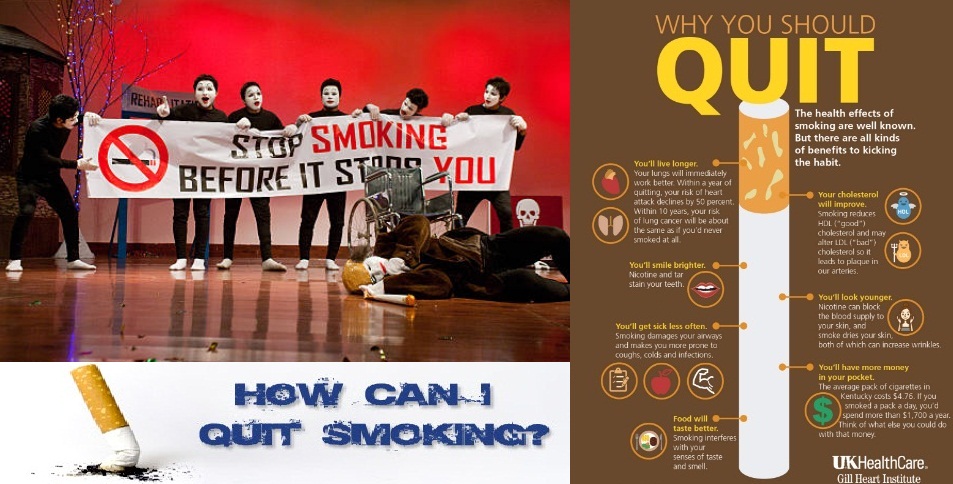Topic We Cover: How to Quit Smoking
1. What Students Need to Know about Tobacco- and Smoke-Free Campuses
2. How to Quit Smoking
3. Why is quitting so hard?
4. Dealing with Withdrawal
5. How to quit smoking Tips
6. 10 Steps to Creating a Tobacco-Free Campus
7. Resources which help students in how to quit smoking
8. 10 Things you need to Stop Doing When You Quit Smoking
9. Sigificant differences among various sociodemographic groups
Now-a-days, apart from electronic gazattes, computer games, and night clubs, one more thing is in trend among college and school sttudents i.e. Smoking. Smoking is that habit which kills our youngsters gradually and they think it’s a fashion. But actually they don’t realize at that moment of time and when they comprehend it will be tough for them to return. Here, through this article we will aware you about the consequences of smoking and how to quit smoking?

What Students Need to Know about Tobacco- and Smoke-Free Campuses
Before proceed towards how to quit smoking it is essential for students to know about tobacco and smoke-free campuses. The vital reason to create smoke- and tobacco-free environments for students is to stay away the non-smokers who can’t endure the smell of cigratte smoke. Another reason is to preserve and protect the health of younger ones who have the rights to not being the part of secondhand smoke.
This issue of tobacco and smoking in children and adolescents is so enormous and hazardous that you can’t even imagine that how to quit smoking. As per the World Bank records, everyday around 82,000-90,000 children from all across the globe commence smoking. About half of them continue to smoke to adulthood and half of the adults are expected to die premature death due to smoking related diseases.
Not only the World Bank, but other renowned associations also present their report on smoking and the National Center for Education is one of them. According to the statistical reports of the National Center for Education, in America over 20.4 million students enrolled in colleges and universities and 40% of them are lie between the ages of 18 and 24 when the chances of health risks associated with smoking are well documented. However, the research demonstrates that the chances of quit smoking is easier before the age of 30. Due to which more and more institute campuses are building tobacco- and smoke-free environments and also providing extra resources to help students to how to quit smoking, vaping and chewing habits.
So, the best way to how to quit smoking is initiate well in college which restricts smoke-free and anti-smoking policies which restrict these activities in public places, such as public buildings, restaurants and bars.
What it means to be a smoke/tobacco-free campus.
In 2009, the guidelines for smoke-free campuses published by American College Health Association. The guidelines suggest colleges should:
- In step towards how to quit smoking campus should strictly Prohibit use of all type of tobacco and associated products like primarily cigarettes, e-cigarettes and chew on all campus grounds and facilities.
- Stop the sale of all tobacco-related products and merchandise on college and university campus.
- Eliminate the advertisement, marketing, and promotion on all tobacco-industry from campus literature.
- Remove all athletic sponsorship from tobacco-related companies.
- Say no to future funding from tobacco companies.
Why going tobacco free is important for colleges.
Tobacco free colleges are essential for students because as per research 99% of smokers start taking tobacco at the average age of 26. That’s why colleges taking initiative for tobacco free campuses and prevent their students and create social environment.
How to Quit Smoking
We know that you already know all the reasons why you should quit smoking, but do you have any idea how to quit smoking? There is not a particular way which we say that it is right or wrong for how to quit smoking, but here we introduce you four major steps which will escalate your chances of success:
- Making the decision to quit
- Setting a quit date and choosing a quit plan
- Dealing with withdrawal
- Staying quit (maintenance)
As we all know that there are so many drawbacks r health related issues of smoking, but still kick off this habit is not easy. Quitting smoke is tough for all whether they are an occasional teen smoker or a lifetime pack-a-day smoker. To help you to find the way for how to quit smoking, you need to know that the presence of nicotine in cigarettes boost up your outlook, unwind and relieve you from stress. So for successful in how to quit smoking you’ll need to change your behavior, enhance your will power, and cope with nicotine withdrawal symptoms. This is not enough; you’ll also look forward for the alternate ways to manage your moods.
Your personal plan for how to quit smoking
When few smokers strongly quit by going cold turkey, most of the people do it on better style with a tailored plan to maintain themselves on a right track. A ‘how to quit smoking’ plan points out both the short-term challenge of stopping smoking and the long-term challenge of preventing relapse. It should also be tailor-made as per your requirement and smoking habits.
Why is quitting so hard?
Smoking tobacco is an addiction both a physical and a psychological. The presence of nicotine in cigarettes provides a addiction and if we eliminate that regular dose of nicotine from your routine which we taken through smoking your body hits you with withdrawal symptoms and craving of nicotine. Because nicotine effect on the brain, many of us smoke to reduce our stress, depression, anxiety, or even boredom and quitting means you need some substitute to cope with those strong feelings to have it.
Those who smoke daily, they don’t realize that smoking is become as a daily ritual in their life. It is normal for them to smoke with morning coffee, during a break time from work or school, or while commute home after a long hectic day, or maybe with your family, friends, or colleagues who smoke.
To stop smoking successfully, you’ll need to cope up from this habit by making yourself strong but in the right way, and with a proper plan for how to quit smoking.
Making the Decision to how to quit smoking
The decision to how to quit smoking is one that only you can make. We come out with the various stages which demonstrate the change in behavior during quitting at various stages. Here are the stages as they apply to quitting smoking:
Pre-contemplation: This stage belongs to those who are not serious about their quitting at this phase of time.
Contemplation: At this stage, smokers are actively thinking about smoke quitting but not ready to make a serious attempt. These people are like, “Yes, I want to quit, but due to so much stress in the school, I’m confused that I'm not sure if I can do it successfully."
Preparation: Smokers at this stage of time are seriously intend to quit in the next month and often have tried to quit in the past 12 months. They usually have a plan.
Action: First 6 months when smoker is actively quitting.
Maintenance: This is the stage after quitting smoking between the period of 6 months to 5 years when the ex-smoker is aware of the troublesome of relapse and take steps to avoid it.
Fix a Date to quit and also prepare a Quit Plan
Have a look to some strategies to try as you prepare yourself in how to quit smoking:
- Keep a smoking diary.
- Acquire from your smoking habits:
- Cut out the cigarettes that you do not feel a strong need to smoke (e.g., eliminate your two "least needed" cigarettes each day).
- Take fewer puffs each time you smoke--one way to do this is to smoke only half of each cigarette.
- Try to chewing gum, whenever you feel like smoking.
- If you have already tried to quit in the past and failed, then review your past once and think what happened at that time and LEARN from your past attempt(s).
- Have one "Stop Smoking Buddy" who can help you in quitting.
- Set a quit date.
Set any upcoming date or any specific date in upcoming month as a quit date and try to quit smoking as per the fixed date. Don’t pick a date too far as it will gives you the time to change your mind. So, once you finalize a date, mark it in your planner and make a strong, personal commitment to yourself to quit on that day.
Now, the next essential step is to opt for a quit plan. As we already mentioned that, there is no right way to quit smoking, but there are two main approaches: cold turkey or gradual withdrawal which will help in ‘how to quit smoking’.
Cold Turkey: This is the approach where you smoke daily in a same frequency or number of cigrattes in a day and then stop totally on quit day, or you can smoke fewer a week before your quit date and then stop on that particular date.
Gradual Withdrawal: in Gradual withdrawal approach, you will cut down the number of cigarettes each day.
Dealing with Withdrawal
Nicotine withdrawal has two parts, the physical and the psychological. A smoker can get rid off from the physical symptoms, while annoying, are not life threatening. It can happen with the help of the nicotine replacement of these physical symptoms. But the real challenge among most of the smokers face is the psychological part of quitting.
If you have been smoking for a long time then it will become a part of almost everything which you do in your life everyday like--waking up in the morning, eating, reading, watching TV, drinking coffee, etc.--and thus it will be tough to unlink from that. One way to overcome these cravings is to identify justifications as they come up. Few of them are:
- How bad is smoking, really? Go back to Why Quit? And think about its negative effects.
- You've got to die of something.
- I'll just have one to get through this rough spot.
- I'll definitely quit it from tomorrow, today is not a good day.
- It's my only vice. (Does that make it okay?)
- Life is no fun without smoking.
The list probably is more. Write down the rationalize which comes to your mind first few days without smoking and try to overcome from that.
How to quit smoking Tips
Below are some tips which will help you stay with your decision to quit smoking. No smoking sign
- Demolish all your cigarettes, ashtrays and lighters.
- Put up a "NO SMOKING" sign or paste a poster in your room which will remind you all the time about your aim.
- Enroll in a smoking cessation program offered by health departments..
- Stop taking any consultation or counselling from self-care center, do not looking for replacement of nicotine or other prescription medication.
- Utilize Online Quitting Resources.
- Let your friends, family, professors and others know that you are quitting and ask for their help.
- Whenever you have a craving for smoking, call your "Stop Smoking Buddy".
- Reduce the urge to smoke by...
- Take a DEEP breaths, DO something else which you like, Drink plenty of water, and DELAY until the urge passes
- Keeping yourself busy in the activity which you like the most
- Do regular exercise.
- Chewing sugarless gum
- Nibbling on low-calorie items such as apples and sugarless candy
- Avoid places which are more chances to smoke-filled settings and situations in which you are more likely to smoke.
- Spend more time on the places where you know you have no chances to smoke.
- Make some new, nonsmoking friends.
- If you still struggling with anxiety, depression, or other mental health issues then read more about Mental Health and tobacco use.
- Prepare a list of things to do instead of smoking, including what you will do when you are stressed. For more information about stress management, visit our College Students & Stress page.
- Do something new, Try your hand in any sport, join any sport activity group.
- Remind yourself of the reasons Why Quit?
- Ur money which you would have spent on cigarettes in a bank and use that money in some good causes or spend on yourself or on your family and friends.
10 Steps to Creating a Tobacco-Free Campus
Are you fed up of cigarette smoke on your way to class or work? Here we mention 10 steps which will help students to create a smoke-free or tobacco-free campus.
Find out who the decision makers are
For a smoke free campus, students need to know about the concern person or the administrator who has the power to enact a campus-wide ban on tobacco use. Meet with them, conduct a meeting, or coordinate through emails regarding the issue.
Understand the administrative process
At this stage, you need to understand about how the decision makers of campus go about accomplishing campus-wide policies?
Prepare
Prepare yourself by gathering all the essential and imperative information about the adverse effects of second-hand smoke and how other college campuses have been enacted on similar smoke-free policies. Create a key statistics of talking points.
Develop a plan
Students are advised to prepare and present a written plan to the school administration. For Nonsmokers’ group has been developed smoke-free campus policy guidelines and tobacco-free policy guidelines students can use
Survey students and faculty
Elect the student body and faculty to complete general level of support for a campus smoking ban. Take a response from a wide age demographic, and from the smokers and the non-smokers.
Start rocking the movement!
Be proactive. Engage reporters and editors at the university newspaper for the initiative support. As they can aware the people through educational articles about current policies of campus smoking, and harmful effects of secondhand smoke.
Hold rallies
Hold rallies on a high-profile area on campus with permissions.
Make it personal
Inspire people through personal triumph of people because people like stories of others. Try to connect with students and faculty who overcame with this addiction and then editors write regarding them about how kicking the habit of smoking changed their lives.
Get social
Spread this information across the globe through social media.
Assess the situation
Students should have a clear idea where the issue of a campus-wide ban on tobacco products stands. Maintain this process until Continue engaging students and campus leaders until a vote on the issue or ban becomes a reality.
Resources which help students in how to quit smoking
Campus resources: By initiating tobacco-free policies
Organizations & groups
Organization help the students in how to quit smoking procedure through various programs. These include:
- American Lung Association.
- Smoking Stops Here.
- Smokefree.gov.
- National Tobacco Cessation Collaborative.
Coaching & medical help
It will help by providing the coaching that can help smokers accomplish their cessation goals.
Mobile apps
There’s an app which help in how to quit smoking include:
- NCI QuitPal. The National Cancer Institute provide free App.
- QuitStart. This App will target young adults, it will help to track cravings, moods, triggers, etc.
- QuitGuide. Developed by cessation counselors, ex smokers, and tobacco control professionals.
- QuitNow! Offers many different tracking features, including time since last cigarette, money saved, and help to cope with the anxiety and stress of quitting.
- Smoke Free.
 Get Updated Review ( Voice Based Alumni Feeback)
Get Updated Review ( Voice Based Alumni Feeback)
-
 Check Review (Alumni Feedback) - Lovely Professional University - [LPU] – Click Here
Check Review (Alumni Feedback) - Lovely Professional University - [LPU] – Click Here -
 Check Review (Alumni Feedback) - Amity University – Click Here
Check Review (Alumni Feedback) - Amity University – Click Here -
 Check Review (Alumni Feedback) - Graphic Era University – Click Here
Check Review (Alumni Feedback) - Graphic Era University – Click Here -
 Check Review (Alumni Feedback) - Jagran Lake City – Click Here
Check Review (Alumni Feedback) - Jagran Lake City – Click Here -
 Check Review (Alumni Feedback) - Apeejay Stya University – Click Here
Check Review (Alumni Feedback) - Apeejay Stya University – Click Here
Products & Practices
Six nicotine therapy administered by the Food and Drug Administration which will help people in how to quit smoking. They include:
- Varenicline (Chantix).
- Nicotine patch (NicoDerm CQ).
- Nicotine gum/lozenges (Nicorette).
- Nicotine Inhaler/Nicotine Nasal spray (Nicotrol).
- Bupropion (Zyban).
Homeopathic methods
10 Things you need to Stop Doing When You Quit Smoking
Always remember that quit means quit, once you quit smoking then you must have to stop few things which will increase your chances to restart the process of smoking again. Few of them are:
- Don't Be Impatient: We all understand that smoking is like a habit which is not easy to quit all of a sudden, so you need to give some time to yourself and to this habit to overcome from this situation and which require lots of patience.
- Don't Worry About the Future
Withdrawl of nicotine surrounds your mind with questions and anxiety about your future without smokinng, it is an advise that don’t be overthink just give some time to yourself and you will be fine soon.
- Don't Be Negative
Posiive attitude is must for quitting smoking and to face the reverse effects of nicotine in your body.
- Don't Neglect Yourself
Don’t ignore your physical health during early smoking cessation
- Eat a well-balanced diet
- Get more rest
- Drink water
- Exercise daily
- Take a daily multi-vitamin
- Don't Drink Alcohol
Tobacco and Alcohol go hand-in-hand so avoid the places and people where there are more chances of the presence of alcohol or cigratte smoke.
- Don't Overdo It
While nicotine withdrawal you need to take care of your health by avoiding various things but don’t ignore your physical health. You feel stress and anxiety but don’t overdo it.
- Don't Take Yourself too Seriously
When you’re hooing through bad days of life such as smoking cessation then, don't be the part of the negative atmosphere of your thoughts. Ignore your bad mood and spend your time with positive people who will motivate you and gives you strength.
- Don't Hesitate to Ask for Help
No need to feel shy or hesitating while asking for a help to overcome from the smoking. Take a help from professionals as well as your friends and family in how to quit smoking activity.
- Don't Think You Can Smoke Just One Cigarette
You have to be very strong so that the though of relapse never come to your mind after quitting.
- Don't Forget Why You Wanted to Quit
Never ever forget the reason of why you quitting this smoking.
Keep a craving journal
Note the moments in each day when you crave a cigarette:
- What time was it?
- How intense was the craving (on a scale of 1-10)?
- What were you doing?
- Who were you with?
- How were you feeling?
- How did you feel after smoking?
Common nicotine withdrawal symptoms include:
- Cigarette cravings
- Irritability, frustration, or anger
- Anxiety or nervousness
- Difficulty concentrating
- Restlessness
- Increased appetite
- Headaches
- Insomnia
- Tremors
- Increased coughing
- Fatigue
- Constipation or upset stomach
- Depression
- Decreased heart rate
Coping with cigarette cravings in the moment
- Find an oral substitute
- Keep your mind busy
- Keep your hands busy
- Brush your teeth
- Drink water
- Light something else
- Get active
- Try to relax
- Go somewhere smoking is not permitted
Preventing weight gain after you stop smoking
- Nurture yourself.
- Eat healthy, varied meals.
- Learn to eat mindfully.
- Drink lots of water.
- Take a walk.
- Snack on guilt-free foods.
Sigificant differences among various sociodemographic groups
Participant characteristics and bivariate analyses examining differences in sociodemographic and psychosocial factors among differing smoking histories
|
|
All participants (N = 4,438)
|
Non-smokers (N = 3094)
|
Quitters (N = 293)
|
Native non-daily smokers (N = 317)
|
Converted non-daily smokers (N = 283)
|
Daily smokers (N = 451)
|
|
|
Variable |
Mean (SD) or N (%) |
Mean (SD) or N (%) |
Mean (SD) or N (%) |
Mean (SD) or N (%) |
Mean (SD) or N (%) |
Mean (SD) or N (%) |
P |
|
Sociodemographics |
|
|
|
|
|
|
|
|
Age (SD) |
23.54 (6.18) |
22.59 (6.18) |
29.69 (11.00) |
21.63 (4.63) |
24.21 (5.95) |
26.97 (8.92) |
<0.001 |
|
Gender (%) |
|
|
|
|
|
|
<0.001 |
|
Male |
1276 (28.8) |
783 (25.3) |
104 (35.5) |
117 (36.9) |
110 (38.9) |
162 (35.9) |
|
|
Female |
3162 (71.2) |
2311 (74.7) |
189 (64.5) |
200 (63.1) |
173 (61.1) |
289 (64.1) |
|
|
Ethnicity (%) |
|
|
|
|
|
|
<0.001 |
|
White |
2024 (45.6) |
1100 (35.6) |
206 (70.3) |
173 (54.6) |
200 (70.7) |
345 (76.5) |
|
|
Black |
1730 (39.0) |
1486 (48.0) |
46 (15.7) |
83 (26.2) |
52 (18.4) |
63 (14.0) |
|
|
Other |
684 (15.4) |
508 (16.4) |
41 (14.0) |
61 (19.2) |
31 (11.0) |
43 (9.5) |
|
|
Parental education (%) |
|
|
|
|
|
|
<0.001 |
|
|
2756 (62.1) |
1944 (62.8) |
183 (62.5) |
181 (57.1) |
141 (49.8) |
307 (68.1) |
|
|
≥Bachelors |
1682 (37.9) |
1150 (37.2) |
110 (37.5) |
136 (42.9) |
142 (50.2) |
144 (31.9) |
|
|
Type of school (%) |
|
|
|
|
|
|
<0.001 |
|
Four-year |
2754 (62.1) |
2156 (69.7) |
111 (37.9) |
211 (66.6) |
149 (52.7) |
127 (28.2) |
|
|
Two-year |
1684 (37.9) |
938 (30.3) |
182 (62.1) |
106 (33.4) |
134 (47.3) |
324 (71.8) |
|
|
Psychosocial factors |
|
|
|
|
|
|
|
|
Attitudes toward smoking, Total (SD) |
88.06 (18.06) |
93.61 (14.89) |
86.29 (19.08) |
81.78 (13.67) |
73.23 (14.93) |
64.82 (16.09) |
<0.001 |
|
Interpersonal |
21.98 (8.14) |
24.75 (6.64) |
21.01 (7.97) |
18.61 (6.03) |
14.51 (6.38) |
10.65 (5.72) |
<0.001 |
|
Laws/restrictions |
35.68 (7.70) |
36.95 (6.86) |
35.56 (7.89) |
35.11 (6.91) |
32.46 (8.12) |
29.53 (9.46) |
<0.001 |
|
concerns |
17.83 (4.18) |
18.45 (3.92) |
17.61 (4.38) |
16.94 (4.27) |
16.13 (4.08) |
15.36 (4.40) |
<0.001 |
|
Marketing |
12.57 (5.00) |
13.47 (4.81) |
12.11 (5.37) |
11.12 (4.18) |
10.13 (4.53) |
9.27 (4.71) |
<0.001 |
|
Harm of occasional cigarette (%) |
|
|
|
|
|
|
<0.001 |
|
No |
1034 (23.3) |
532 (17.2) |
70 (23.9) |
129 (40.7) |
129 (45.6) |
174 (38.6) |
|
|
Yes |
3404 (76.7) |
2562 (82.8) |
223 (76.1) |
188 (59.3) |
154 (54.4) |
277 (61.4) |
|
|
Depressive symptoms (SD) |
1.24 (1.31) |
1.16 (1.27) |
1.19 (1.34) |
1.44 (1.36) |
1.45 (1.38) |
1.50 (1.47) |
<0.001 |
|
Parents smoked (%) |
|
|
|
|
|
|
<0.001 |
|
No |
2654 (59.8) |
2037 (65.8) |
129 (44.0) |
203 (64.0) |
136 (48.1) |
149 (33.0) |
|
|
Yes |
1784 (40.2) |
1057 (34.2) |
164 (56.0) |
114 (36.0) |
147 (51.9) |
302 (67.0) |
|
|
Number of friends that smoke (SD) |
1.47 (1.57) |
0.98 (1.28) |
1.82 (1.53) |
1.94 (1.43) |
2.69 (1.46) |
3.52 (1.36) |
<0.001 |
|
Other substance use, past 30 days |
|
|
|
|
|
|
|
|
Any alcohol use (%) |
|
|
|
|
|
|
<0.001 |
|
No |
1925 (43.4) |
1591 (51.4) |
110 (37.5) |
56 (17.7) |
35 (12.4) |
133 (29.5) |
|
|
Yes |
2513 (56.6) |
1503 (48.6) |
183 (62.5) |
261 (82.3) |
248 (87.6) |
318 (70.5) |
|
|
Any binge drinking (%) |
|
|
|
|
|
|
<0.001 |
|
No |
3441 (77.5) |
2642 (85.4) |
213 (72.7) |
161 (50.8) |
141 (49.8) |
284 (63.0) |
|
|
Yes |
997 (22.5) |
452 (14.6) |
80 (27.3) |
156 (49.2) |
142 (50.2) |
167 (37.0) |
|
|
Marijuana (%) |
|
|
|
|
|
|
<0.001 |
|
No |
3795 (86.2) |
2805 (91.5) |
253 (86.6) |
212 (67.5) |
196 (70.0) |
329 (73.3) |
|
|
Yes |
606 (13.8) |
261 (8.5) |
39 (13.4) |
102 (32.5) |
84 (30.0) |
120 (26.7) |
|
|
Other tobacco products (%) |
|
|
|
|
|
|
<0.001 |
|
No |
3567 (82.0) |
2747 (90.4) |
237 (83.5) |
117 (38.4) |
161 (58.1) |
305 (68.7) |
|
|
Yes |
782 (18.0) |
292 (9.6) |
47 (16.5) |
188 (61.6) |
116 (41.9) |
139 (31.3) |
Significant difference in the number of smokers who smoked mentholated cigarettes among current smokers
Bivariate analyses examining differences in smoking-related characteristics among differing smoking histories
|
|
Native non-daily smokers (N = 317)
|
Converted non-daily smokers (N = 283)
|
Daily smokers (N = 451)
|
|
|
Variable |
Mean (SD) or N (%) |
Mean (SD) or N (%) |
Mean (SD) or N (%) |
P |
|
Number of days smoked, past 30 (SD) |
5.43 (6.21) |
14.44 (9.99) |
30.00 (0.00) |
<0.001 |
|
Average CPD (SD) |
2.31 (4.67) |
4.65 (5.36) |
11.77 (7.14) |
<0.001 |
|
Menthol (%) |
|
|
|
0.04 |
|
No |
150 (57.7) |
147 (58.8) |
206 (49.8) |
|
|
Yes |
110 (42.3) |
103 (41.2) |
208 (50.2) |
|
|
First cigarette, 30 min of waking (%) |
|
|
|
<0.001 |
|
No |
251 (96.5) |
223 (89.2) |
190 (45.9) |
|
|
Yes |
9 (3.5) |
27 (10.8) |
224 (54.1) |
|
|
Quit attempts, past 12 months (%) |
|
|
|
<0.001 |
|
No |
40 (15.4) |
10 (4.0) |
4 (1.0) |
|
|
Yes |
220 (84.6) |
240 (96.0) |
410 (99.0) |
|
|
Ready to quit in next month (%) |
|
|
|
<0.001 |
|
No |
143 (55.0) |
153 (61.2) |
376 (90.8) |
|
|
Yes |
117 (45.0) |
97 (38.8) |
38 (9.2) |
|
|
Social smoker (%) |
|
|
|
<0.001 |
|
No |
53 (20.4) |
122 (48.8) |
354 (85.5) |
|
|
Yes |
207 (79.6) |
128 (51.2) |
60 (14.5) |
|
|
Consider yourself a smoker (%) |
|
|
|
<0.001 |
|
No |
273 (86.1) |
124 (43.8) |
6 (1.3) |
|
|
Yes |
44 (13.9) |
159 (56.2) |
445 (98.7) |
|
|
Self-efficacy—intrinsic (SD) |
22.52 (7.38) |
19.92 (6.55) |
16.99 (8.31) |
<0.001 |
|
Self-efficacy—extrinsic (SD) |
21.78 (7.02) |
19.61 (5.74) |
17.17 (7.74) |
<0.001 |
|
TSRQ—controlled motivation (SD) |
27.05 (12.68) |
24.18 (11.39) |
21.11 (10.91) |
<0.001 |
|
TSRQ—autonomous motivation (SD) |
32.65 (8.95) |
32.49 (9.07) |
30.94 (9.96) |
0.03 |
|
TSRQ—amotivation (SD) |
6.75 (3.64) |
5.76 (3.45) |
5.86 (3.65) |
0.002 |
Binary logistic regression model indicating factors associated with readiness to quit in the next month among current smokers
|
|
Model A
|
Model B
|
Model C
|
||||||
|
Variable |
OR |
CI |
P |
OR |
CI |
P |
OR |
CI |
P |
|
Smoking status |
|
|
|
|
|
|
|
|
|
|
Native non-daily smoker |
Ref |
— |
— |
Ref |
— |
— |
Ref |
— |
|
|
Converted non-daily smoker |
0.78 |
0.55, 1.10 |
0.16 |
0.80 |
0.55, 1.15 |
0.23 |
2.15 |
1.32, 3.49 |
0.002 |
|
Daily smoker |
0.12 |
0.08, 0.19 |
<0.001 |
0.12 |
0.08, 0.20 |
<0.001 |
0.97 |
0.42, 2.28 |
0.95 |
|
Age |
|
|
|
0.99 |
0.96, 0.20 |
0.49 |
0.98 |
0.95, 1.01 |
0.23 |
|
Gender |
|
|
|
|
|
|
|
|
0.19 |
|
Male |
|
|
|
Ref |
— |
— |
Ref |
— |
|
|
Female |
|
|
|
1.56 |
1.12, 2.18 |
0.009 |
1.28 |
0.89, 1.85 |
|
|
Ethnicity |
|
|
|
|
|
|
|
|
|
|
White |
|
|
|
Ref |
— |
— |
Ref |
— |
|
|
Black |
|
|
|
0.94 |
0.61, 1.44 |
0.76 |
1.15 |
0.72, 1.81 |
0.55 |
|
Other |
|
|
|
0.94 |
0.59, 1.53 |
0.83 |
1.09 |
0.65, 1.84 |
0.75 |
|
Parental education |
|
|
|
|
|
|
|
|
|
|
< Bachelors |
|
|
|
Ref |
— |
— |
Ref |
— |
|
|
≥ Bachelors |
|
|
|
0.87 |
0.62, 1.22 |
0.43 |
0.83 |
0.58, 1.20 |
0.33 |
|
Type of school |
|
|
|
|
|
|
|
|
|
|
Four-year |
|
|
|
Ref |
— |
— |
Ref |
— |
|
|
Two-year |
|
|
|
0.99 |
0.69, 1.42 |
0.96 |
1.15 |
0.78, 1.72 |
0.48 |
|
Attitudes toward smoking |
|
|
|
|
|
|
1.03 |
1.02, 1.04 |
<.001 |
|
Number of days smoked, past 30 |
|
|
|
|
|
|
0.94 |
0.92, 0.97 |
<.001 |
|
First cigarette, 30 min of waking |
|
|
|
|
|
|
|
|
|
|
No |
|
|
|
|
|
|
Ref |
— |
|
|
Yes |
|
|
|
|
|
|
2.11 |
1.23, 3.62 |
0.006 |
|
Consider yourself a smoker |
|
|
|
|
|
|
|
|
|
|
No |
|
|
|
|
|
|
Ref |
— |
|
|
Yes |
|
|
|
|
|
|
0.55 |
0.32, 0.95 |
0.03 |
|
Self-efficacy—extrinsic |
|
|
|
|
|
|
1.02 |
1.00, 1.05 |
0.07 |
|
TSRQ—autonomous motivation |
|
|
|
|
|
|
1.04 |
1.01, 1.06 |
0.001 |






